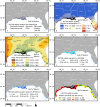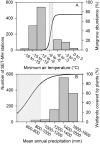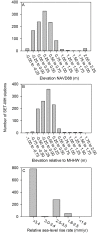Assessing coastal wetland vulnerability to sea-level rise along the northern Gulf of Mexico coast: Gaps and opportunities for developing a coordinated regional sampling network
- PMID: 28902904
- PMCID: PMC5597133
- DOI: 10.1371/journal.pone.0183431
Assessing coastal wetland vulnerability to sea-level rise along the northern Gulf of Mexico coast: Gaps and opportunities for developing a coordinated regional sampling network
Abstract
Coastal wetland responses to sea-level rise are greatly influenced by biogeomorphic processes that affect wetland surface elevation. Small changes in elevation relative to sea level can lead to comparatively large changes in ecosystem structure, function, and stability. The surface elevation table-marker horizon (SET-MH) approach is being used globally to quantify the relative contributions of processes affecting wetland elevation change. Historically, SET-MH measurements have been obtained at local scales to address site-specific research questions. However, in the face of accelerated sea-level rise, there is an increasing need for elevation change network data that can be incorporated into regional ecological models and vulnerability assessments. In particular, there is a need for long-term, high-temporal resolution data that are strategically distributed across ecologically-relevant abiotic gradients. Here, we quantify the distribution of SET-MH stations along the northern Gulf of Mexico coast (USA) across political boundaries (states), wetland habitats, and ecologically-relevant abiotic gradients (i.e., gradients in temperature, precipitation, elevation, and relative sea-level rise). Our analyses identify areas with high SET-MH station densities as well as areas with notable gaps. Salt marshes, intermediate elevations, and colder areas with high rainfall have a high number of stations, while salt flat ecosystems, certain elevation zones, the mangrove-marsh ecotone, and hypersaline coastal areas with low rainfall have fewer stations. Due to rapid rates of wetland loss and relative sea-level rise, the state of Louisiana has the most extensive SET-MH station network in the region, and we provide several recent examples where data from Louisiana's network have been used to assess and compare wetland vulnerability to sea-level rise. Our findings represent the first attempt to examine spatial gaps in SET-MH coverage across abiotic gradients. Our analyses can be used to transform a broadly disseminated and unplanned collection of SET-MH stations into a coordinated and strategic regional network. This regional network would provide data for predicting and preparing for the responses of coastal wetlands to accelerated sea-level rise and other aspects of global change.
Conflict of interest statement
Figures






References
-
- McKee K, Rogers K, Saintilan N. Response of salt marsh and mangrove wetlands to changes in atmospheric CO2, climate, and sea level In: Middleton BA, editor. Global Change and the Function and Distribution of Wetlands: Global Change Ecology and Wetlands. Dordrecht, Netherlands: Springer; 2012. p. 63–96.
-
- Gabler CA, Osland MJ, Grace JB, Stagg CL, Day RH, Hartley SB, et al. Macroclimatic change expected to transform coastal wetland ecosystems this century. Nature Climate Change. 2017;7:142–147.
-
- Enwright NM, Griffith KT, Osland MJ. Barriers to and opportunities for landward migration of coastal wetlands with sea-level rise. Frontiers in Ecology and the Environment. 2016;14(6):307–316.
-
- Doyle TW, Krauss KW, Conner WH, From AS. Predicting the retreat and migration of tidal forests along the northern Gulf of Mexico under sea-level rise. Forest Ecology and Management. 2010;259(4):770–777.
-
- Kirwan ML, Megonigal JP. Tidal wetland stability in the face of human impacts and sea-level rise. Nature. 2013;504(7478):53–60. doi: 10.1038/nature12856 - DOI - PubMed
MeSH terms
LinkOut - more resources
Full Text Sources
Other Literature Sources
Medical

